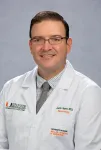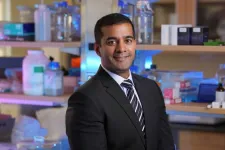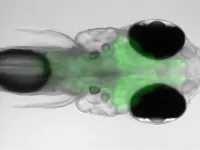(Press-News.org) A new machine learning model – trained on video and audio recorded from the first-person perspective of one young child for over a year – has provided new insights into early language acquisition. Not only do the findings offer a valuable framework to understand how children learn words and concepts, but they could be critical in developing artificial intelligence (AI) systems that can learn language in more human-like ways. Beginning around 6 to 9 months of age, children begin acquiring their first words, connecting spoken words to real-world objects and concepts. By the time they are 1.5 to 2 years of age, most children can comprehend an average of 300 words. However, how children acquire their first words and how these words become grounded to their visual counterparts is poorly understood. Although this topic is widely debated and several hypotheses have been proposed, early language acquisition has traditionally been examined in laboratory settings with findings that lack generalizability to real-world settings. Better understanding this process in children could inform next-generation multi-modal AI systems that develop links between words and visual representations.
Here, Wai Keen Vong and colleagues address these questions using a novel approach. They introduce the Child’s View for Contrastive Learning model (CVCL). Using longitudinal head-mounted camera recordings from a single child’s first-person experience over a 1.5-year period (age 6-25 months), Vong et al. trained the CVCL – a relatively generic neural network – on video frames (representing what the child was seeing) that co-occurred with child-directed linguistic utterances (what the child was hearing). Through this, the authors show that the model could learn word-referent mappings present in the child’s everyday experience. Even though the model was trained on a strict subset of actual naturalistic experiences, it was able to generalize beyond the specific visual objects seen in the child’s environment during training and align its visual and linguistic representations of them. According to Vong et al., the model – with limited sensory input and relatively generic learning mechanisms – provides a computational foundation for investigating how children acquire their first words and how those words can become grounded to the visual world. Despite the study’s conclusions, the authors highlight several limitations of their model in fully filling the gaps in the understanding of word learning in children.
END
AI system reveals new insights into early language acquisition through the experience of a single child
2024-02-01
ELSE PRESS RELEASES FROM THIS DATE:
Targeting treatment resistance in chronic lymphocytic leukemia
2024-02-01
MIAMI, FLORIDA (EMBARGOED UNTIL FEB. 1, 2024, AT 2 P.M. ET) – New research from Sylvester Comprehensive Cancer Center at the University of Miami Miller School of Medicine and collaborating organizations has identified a next-generation BTK degrader that could help overcome treatment resistance in chronic lymphocytic leukemia (CLL) and related blood cancers.
Their findings, published Feb. 2 in the journal Science, could offer a therapeutic option for CLL patients whose tumors become drug-resistant or are unresponsive to frontline treatment.
“This new compound not only inhibits the cellular molecule BTK, but goes further by taking aim at the target ...
Sustainable carbon removals limits identified, huge climate mitigation challenge revealed
2024-02-01
*Embargoed until 14:00 US Eastern / 19:00 UK GMT / 20:00 Europe CET – Thursday 1 February*
Governments and businesses are relying on dangerous amounts of future removal of carbon dioxide (CO2) from the atmosphere, instead of more rapidly reducing emissions and phasing out fossil fuels. This problem is partly due to an incomplete picture1 of the damaging consequences of carbon dioxide removal for people, food security and natural ecosystems, according to new research published in Science.
The paper finds that the carbon dioxide removal potential currently reported by the UN ...
Whole-brain projection patterns of single neurons in mouse hippocampus unveiled
2024-02-01
A study published in Science on Feb. 1 reported a comprehensive database of single-neuron projectomes consisting of over 10,000 mouse hippocampal neurons, thus revealing the spatial connectivity patterns of mouse hippocampal neurons at the mesoscopic level.
The study was conducted by teams from the Center for Excellence in Brain Science and Intelligence Technology (CEBSIT), the Institute of Neuroscience of the Chinese Academy of Sciences (CAS), the HUST-Suzhou Institute for Brainsmatics, Hainan University, the Kunming Institute of Zoology of CAS, Lingang Laboratory, and the Shanghai Center for ...
New study suggests culling animals who ‘don’t belong’ can be a flawed nature conservation practice
2024-02-01
New research published today in the journal Science has concluded that eradicating animals on the basis that they are not native in order to protect plant species, can be a flawed practice costing millions of dollars, and resulting in the slaughter of millions of healthy wild animals.
Introduced large herbivores, or megafauna, are claimed to have distinct and harmful ecological impacts, including damaging sensitive plants and habitats, reducing native plant diversity, and facilitating introduced plants. However, up to now these impacts have been studied without comparison to a proper ...
IU surgeon-scientist studying physiological effect of microorganisms in sinuses of chronic rhinosinusitis patients
2024-02-01
INDIANAPOLIS—An Indiana University School of Medicine surgeon-scientist is leading a multi-institutional grant investigating the role of the sinus microbiome in chronic rhinosinusitis, an inflammatory disease that causes the lining of the sinuses to swell. The research team will study biospecimens from human sinus surgery patients in the lab and examine how bacteria in the microbiome shape the disease process and might offer novel therapeutic strategies.
Vijay Ramakrishnan, MD, professor of otolaryngology—head ...
Stand Up to Cancer announces changes to scientific advisory committee
2024-02-01
LOS ANGELES – February 1, 2024 – Stand Up To Cancer® (SU2C) today announced changes to its Scientific Advisory Committee (SAC), which oversees SU2C’s scientific research.
Composed of cancer research leaders from academic, government, industry, and advocacy fields, SU2C’s SAC sets direction for research initiatives, reviews proposals for new grant awards, and conducts rigorous oversight of all active grants in the SU2C research portfolio in collaboration with SU2C’s president and CEO Julian Adams, Ph.D.
World renowned cancer researcher and Nobel laureate Phillip A. Sharp, Ph.D., who has chaired the SAC since SU2C launched in ...
Small RNAs take on the big task of helping skin wounds heal better and faster with minimal scarring
2024-02-01
Philadelphia, February 1, 2024 – New findings in The American Journal of Pathology, published by Elsevier, report that a class of small RNAs (microRNAs), microRNA-29, can restore normal skin structure rather than producing a wound closure by a connective tissue (scar). Any improvement of normal skin repair would benefit many patients affected by large-area or deep wounds prone to dysfunctional scarring.
Because the burden of non-healing wounds is so significant, it is sometimes called a “silent pandemic.” Worldwide, costs associated with wound care are expected to ...
Rural placements for medical students feed ‘pipeline’ for new family docs
2024-02-01
EDMONTON — New research shows an innovative education program is helping to address Alberta’s rural doctor shortage by making it more likely medical students will set up a rural family practice after graduation.
The University of Alberta was one of the first medical schools in Canada to set up its Rural Integrated Community Clerkship program back in 2007. It sends up to 25 third-year students for 10-month intensive work experiences with a single or small number of teaching physicians.
Instead of rotating to a new specialty placement every four to six weeks as in an urban ...
Zebrafish navigate to find their comfortable temperature
2024-02-01
All animals need to regulate their body temperature and cannot survive for long if it gets too high or too low. Warm-blooded organisms like humans have various ways to do this. They release heat by sweating or expanding the blood vessels in their skin, while shivering or burning fat in their brown adipose tissue has the opposite effect.
Cold-blooded animals such as the zebrafish, by contrast, cannot do any of these, so they have a different strategy. They look for places nearby that are at their “comfortable temperature,” just like how we might go out into the sun when we feel chilly or seek out some shade once it gets too ...
Buck scientists discover a potential way to repair synapses damaged in Alzheimer’s disease
2024-02-01
While newly approved drugs for Alzheimer’s show some promise for slowing the memory-robbing disease, the current treatments fall far short of being effective at regaining memory. What is needed are more treatment options targeted to restore memory, said Buck Assistant Professor Tara Tracy, PhD, the senior author of a study that proposes an alternate strategy for reversing the memory problems that accompany Alzheimer’s disease and related dementias.
Since most current research on potential treatments for Alzheimer’s focuses on reducing the toxic proteins, such as tau and amyloid beta, that accumulate in ...





